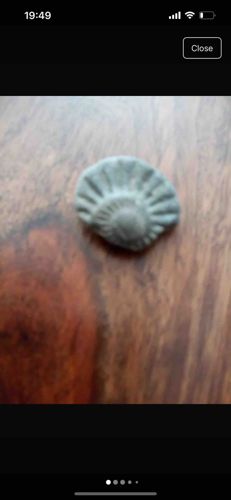
Ammonite Fossil
The item is a fossilized ammonite, characterized by its distinctive planospiral, coiled shell structure. It appears to be relatively small, likely fitting within the palm of a hand. The color is a muted, pale greenish-gray, suggesting the natural mineralization process it underwent. The shell exhibits prominent radial ribs or costae that emanate from the central umbilical region and extend outwards towards the venter, though the outer edge is not entirely clear. The center of the ammonite shows a relatively flat or slightly depressed area where the initial whorls are visible, surrounded by these radiating ridges. There are no obvious signs of repair or major damage, but the surface exhibits a natural, somewhat granular texture consistent with fossilization. Given the visible features, it appears to be a well-preserved specimen, with good definition of the costae, which are a key identification feature for ammonites. The overall shape is regular and symmetrical, indicative of a complete fossil. There are no discernible maker's marks or signatures, as is typical for natural fossils. Based on its morphology, it likely belongs to a species from the Mesozoic Era, specifically the Jurassic or Cretaceous period, when ammonites were abundant. The quality of preservation appears to be good for a natural specimen, showcasing clear anatomical features. The item's condition indicates natural wear and patination acquired over geological time, but without destructive handling or significant recent damage. Its compact size and clear features make it an appealing example of a common fossil type.
AI-Generated Appraisal Disclaimer
Estimated Value
$60-90
Basic Information
Category
Fossil
Appraised On
November 28, 2025
Estimated Value
$60-90
Item Description
The item is a fossilized ammonite, characterized by its distinctive planospiral, coiled shell structure. It appears to be relatively small, likely fitting within the palm of a hand. The color is a muted, pale greenish-gray, suggesting the natural mineralization process it underwent. The shell exhibits prominent radial ribs or costae that emanate from the central umbilical region and extend outwards towards the venter, though the outer edge is not entirely clear. The center of the ammonite shows a relatively flat or slightly depressed area where the initial whorls are visible, surrounded by these radiating ridges. There are no obvious signs of repair or major damage, but the surface exhibits a natural, somewhat granular texture consistent with fossilization. Given the visible features, it appears to be a well-preserved specimen, with good definition of the costae, which are a key identification feature for ammonites. The overall shape is regular and symmetrical, indicative of a complete fossil. There are no discernible maker's marks or signatures, as is typical for natural fossils. Based on its morphology, it likely belongs to a species from the Mesozoic Era, specifically the Jurassic or Cretaceous period, when ammonites were abundant. The quality of preservation appears to be good for a natural specimen, showcasing clear anatomical features. The item's condition indicates natural wear and patination acquired over geological time, but without destructive handling or significant recent damage. Its compact size and clear features make it an appealing example of a common fossil type.
Related Tags
Get Your Items Appraised
Instant estimates of your treasures with AI-powered instant appraisals